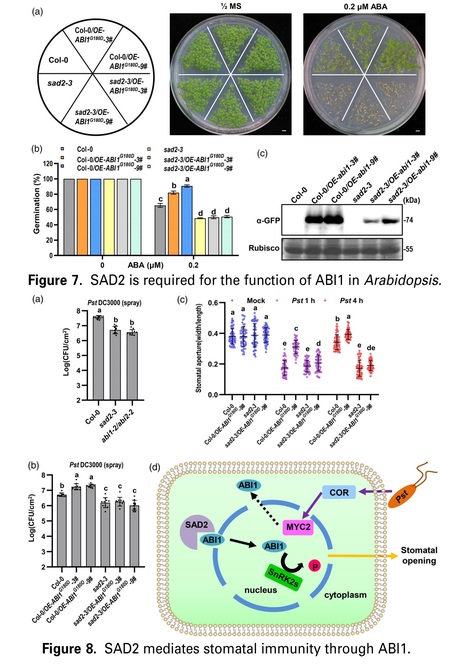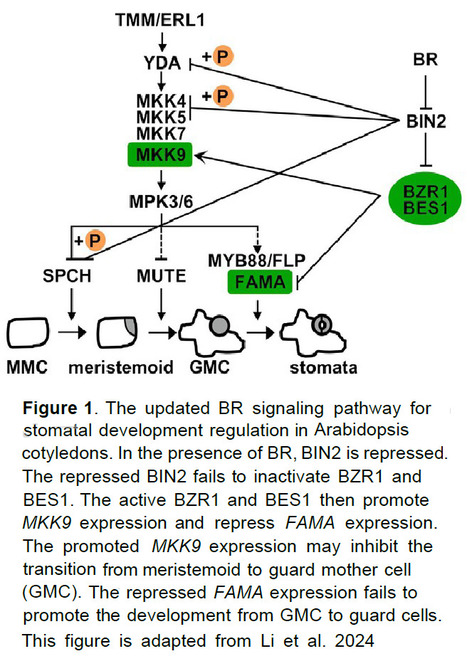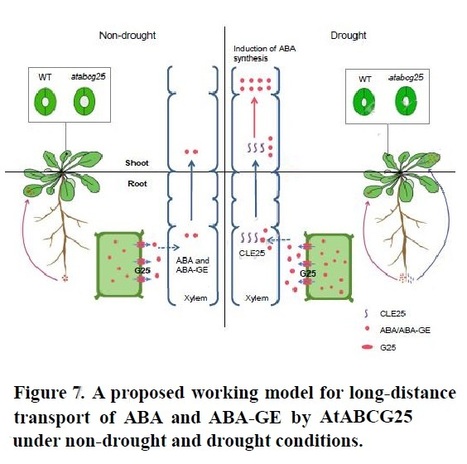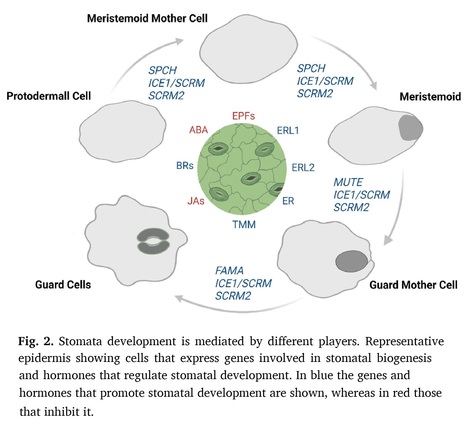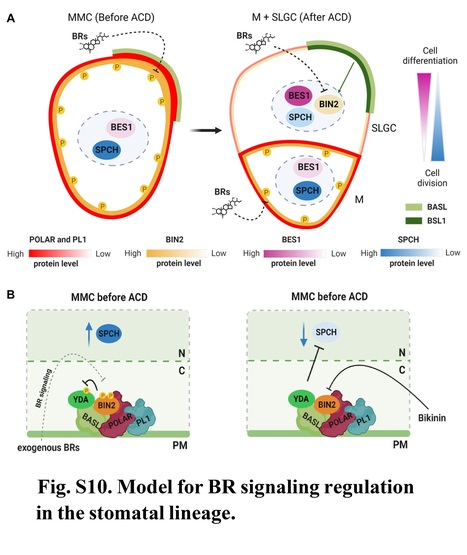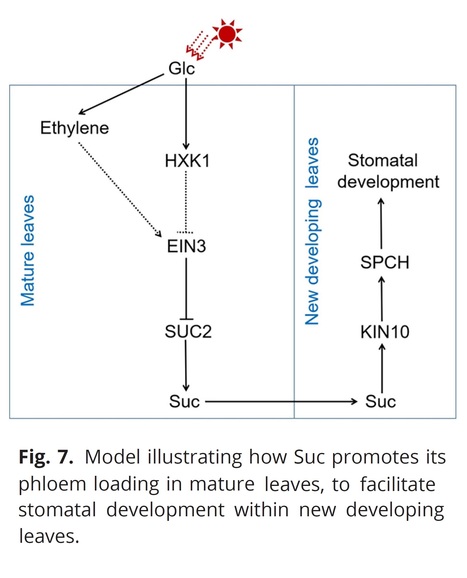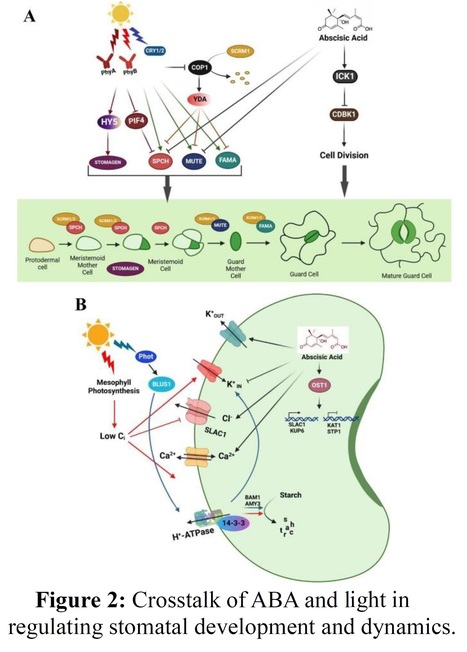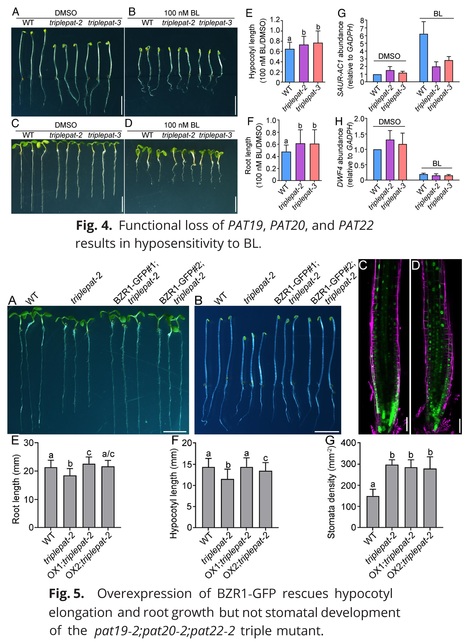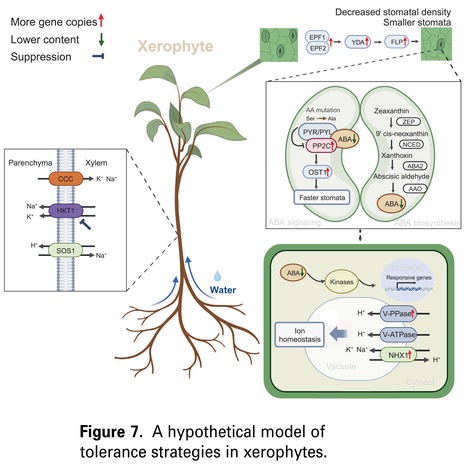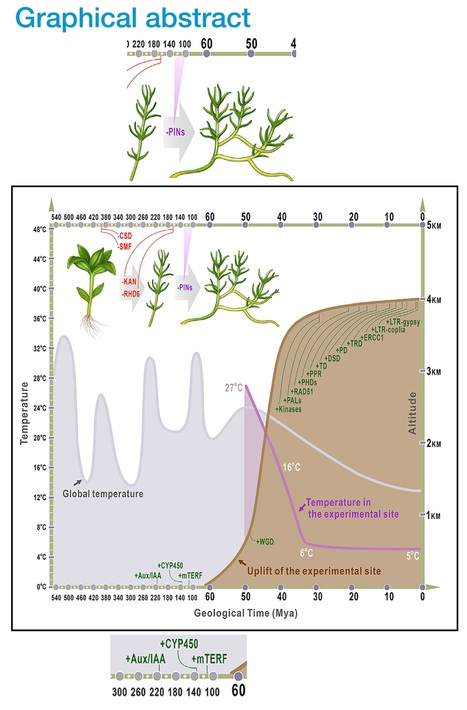Get Started for FREE
Sign up with Facebook Sign up with X
I don't have a Facebook or a X account

 Your new post is loading... Your new post is loading...
 Your new post is loading... Your new post is loading...
From
doi
Authors: Mengmeng Zhang and Shuqun Zhang.
Current Biology (2024) Summary: "Dynamic cellular localization of receptors is key to the perception of their peptide ligands and the activation of downstream signaling pathways. A new study identifies NRPMs as novel regulators of ERECTA receptor localization and stomatal formation downstream of the EPF1/EPF2 peptide ligands and upstream of the YDA MAPK cascade."
Julio Retamales's insight:
Commentary on the relevant article by Xue et al. ("Membrane-associated NRPM proteins are novel suppressors of stomatal production in Arabidopsis") in Current Biology. Such article was recently posted here and is to be found at:
Text of the figure above: " Figure 1. NRPM proteins maintain the plasma membrane localization of ERECTA to ensure normal cell–cell communication during stomatal formation. NRPMs, a family of plasma membrane peripheral proteins, play a positive role in maintaining the plasma-membrane localization of the ERECTA receptor, which is key to the functionality of the receptor complex composed of ERECTA-family (ER-f), TOO-MANY-MOUTH (TMM), and SOMATIC EMBRYOGENESIS RECEPTOR-LIKE KINASES (SERKs). Perception of the EPIDERMAL PATTERNING FACTOR 1 (EPF1) and EPF2 peptide ligands originated from neighboring cells by this receptor complex triggers the activation of the YDA/MAPKKK3/MAPKKK5–MKK4/MKK5–MPK3/MPK6 cascade. The activated MPK3/MPK6 then phosphorylate the downstream substrates including SCREAM (SCRM) and SPEECHLESS (SPCH) to inhibit stomatal development, a process key to the normal distribution of stomata in the plant epidermis."
Author: Yee-Shan Ku. Plant Physiology (2024) Excerpts: "In this issue of Plant Physiology, Li et al., report the role of BR in stomatal development in cotyledons in the dark, where light signaling does not interfere with the process (Li et al., 2024). The homologous transcription factors (TFs) BZR1 and BES1 are the master BR signaling components (Wang et al., 2002; Yin et al., 2002; Li et al., 2018). The TFs also play a role in stomatal development, and the functional gain of BZR1 or BES1 inhibited stomatal development in Arabidopsis cotyledons (Li et al., 2024). To search for the target genes of BZR1 and BES1, the authors selected candidate stomatal development genes with BR regulatory elements in their promoters." "BR has been known to regulate stomatal development via the action of BZR1 and BES1. In this study, the authors integrated BZR1 and BES1 into the BR-mediated stomatal development signaling pathway in Arabidopsis cotyledons, identified MKK9 and FAMA as the bona fide targets of BZR1 and BES1, and updated the pathway with these components."
Julio Retamales's insight:
Commentary on the article by Li et al. ("Brassinosteroid regulates stomatal development in etiolated cotyledons via 2 transcription factors BZR1 and BES1"), which was already posted here and is to be found at:
Authors: Qin Yang, Xiaojuan Deng, Ting Liu, Jiayun Qian, Penghong Zhang, Engao Zhu, Jingqi Wang, Xiaoxian Zhu, Guzel Kudoyarova, Jiangzhe Zhao and Kewei Zhang.
Plant Physiology (2024) One-sentence summary: An ABC transporter facilitates root-to-shoot translocation of root-derived abscisic acid, influencing stomatal movements in shoots under non-drought or drought conditions. Abstract: "The phytohormone abscisic acid (ABA) plays a central role in regulating stomatal movements under drought conditions. The root-derived peptide CLAVATA3/EMBRYO SURROUNDING REGION-RELATED 25 (CLE25) moves from the root to shoot for activating ABA biosynthesis under drought conditions. However, the root-to-shoot translocation of root-derived ABA and its regulation of stomatal movements in the shoot remain to be clarified. Here, we reveal that the ABA transporter ATP-binding cassette subfamily G member 25 (AtABCG25) mediates root-to-shoot translocation of ABA and ABA-glucosyl ester (ABA-GE) in Arabidopsis (Arabidopsis thaliana). Isotope-labeled ABA tracer experiments and hormone quantification in xylem sap showed that the root-to-shoot translocation of ABA and ABA-GE was substantially impaired in the atabcg25 mutant under non-drought and drought conditions. However, the contents of ABA and ABA-GE in the leaves were lower in the atabcg25 mutant than in the wild type (WT) under non-drought but similar under drought conditions. Consistently, the stomatal closure was suppressed in the atabcg25 mutant under non-drought but not under drought conditions. The transporter activity assays showed that AtABCG25 directly exported ABA and ABA-GE in planta and in yeast (Saccharomyces cerevisiae) cells. Thus, we proposed a working model in which root-derived ABA transported by AtABCG25 via xylem mediates stomatal movements in the shoot under non-drought conditions but might exhibit little effect on stomatal movements under drought conditions. These findings extend the functions of AtABCG25 and provide insights into the long-distance translocation of ABA and its role in stomatal movements."
Julio Retamales's insight:
Important finding!
Authors: Deka Mohamed, Eliana Vonapartis, Dennedy Yrvin Corcega and Sonia Gazzarrini. Development (2023) Summary: ABA mediates repression of stomatal proliferation through the EPF2-SPCH pathway and controls stomatal spacing in parallel with EPF1 in Arabidopsis. Abstract: "Adaptation to dehydration stress requires plants to coordinate environmental and endogenous signals to inhibit stomatal proliferation and modulate their patterning. The stress hormone abscisic acid (ABA) induces stomatal closure and restricts stomatal lineage to promote stress tolerance. Here, we report that mutants with reduced ABA levels, xer-1, xer-2 and aba2-2, developed stomatal clusters. Similarly, the ABA signaling mutant snrk2.2/2.3/2.6, which lacks core ABA signaling kinases, also displayed stomatal clusters. Exposure to ABA or inhibition of ABA catabolism rescued the increased stomatal density and spacing defects observed in xer and aba2-2, suggesting that basal ABA is required for correct stomatal density and spacing. xer-1 and aba2-2 displayed reduced expression of EPF1 and EPF2, and enhanced expression of SPCH and MUTE. Furthermore, ABA suppressed elevated SPCH and MUTE expression in epf2-1 and epf1-1, and partially rescued epf2-1 stomatal index and epf1-1 clustering defects. Genetic analysis demonstrated that XER acts upstream of the EPF2-SPCH pathway to suppress stomatal proliferation, and in parallel with EPF1 to ensure correct stomatal spacing. These results show that basal ABA and functional ABA signaling are required to fine-tune stomatal density and patterning."
Julio Retamales's insight:
Relevant article!
Author: José Manuel Ugalde. Plant Physiology (2024) Excerpts: "Controlled stomata closure becomes a necessary adaptation response of plants toward their environment in a process intricately but not exclusively linked to abscisic acid (ABA) and reactive oxygen species (ROS) (Fig. 1A)" "In this issue of Plant Physiology, Qin et al. show how VDAC3, a mitochondrial voltage-dependent anion channel protein linked to adaptation responses, is an essential component of the redundant PYR/PYL/SnRK2 signaling core for ABA-mediated stomatal closure (Fig. 1A)." "This article unveils VDAC3 as a critical player in the redundancy control of ABA-mediated stomatal closure. The protein interacts with multiple PYLs, PYRs, and SnRK2s, forming a regulatory module crucial for ABA-dependent stomatal closure. The study suggests that VDAC3 acts as a scaffold protein in mitochondria, enhancing the efficiency of ABA-sensing complexes."
Julio Retamales's insight:
Commentary on the article by Qin et al. ("Mitochondrial VOLTAGE-DEPENDENT ANION CHANNEL 3 regulates stomatal closure by abscisic acid signaling"), which is also posted here.
From
doi
Authors: Priscilla Falquetto-Gomes, Welson Júnior Silva, João Antonio Siqueira, Wagner L. Araújo and Adriano Nunes-Nesi.
Journal of Plant Physiology (2024) Abstract: "Stomata, small hydromechanical valves in the leaf epidermis, are fundamental in regulating gas exchange and water loss between plants and the environment. Stomatal development involves a series of coordinated events ranging from the initial cell division that determines the meristemoid mother cells to forming specialized structures such as guard cells. These events are orchestrated by the transcription factors SPEECHLESS, FAMA, and MUTE through signaling networks. The role of plant hormones (e.g., abscisic acid, jasmonic acid, and brassinosteroids) in regulating stomatal development has been elucidated through these signaling cascades. In addition, environmental factors, such as light availability and CO2 concentration, also regulate the density and distribution of stomata in leaves, ultimately affecting overall water use efficiency. In this review, we highlight the mechanisms underlying stomatal development, connecting key signaling processes that activate or inhibit cell differentiation responsible for forming guard cells in the leaf epidermis. The factors responsible for integrating transcription factors, hormonal responses, and the influence of climatic factors on the signaling network that leads to stomatal development in plants are further discussed. Understanding the intricate connections between these factors, including the metabolic regulation of plant development, may enable us to maximize plant productivity under specific environmental conditions in changing climate scenarios."
From
doi
Authors: Eun-Ji Kim, Cheng Zhang, Boyu Guo, Thomas Eekhout, Anaxi Houbaert, Jos R. Wendrich, Niels Vandamme, Manish Tiwari, Claire Simon--Vezo, Isabelle Vanhoutte, Yvan Saeys, Kun Wang, Yuxian Zhu, Bert De Rybel and Eugenia Russinova.
PNAS (2022) Significance: Stomata, the gas exchange pores in plant epidermis, are formed by series of cell divisions and cell-fate transitions. Stomatal development is tightly controlled by endogenous and environmental cues. The BIN2 kinase, a key negative regulator of brassinosteroid signaling controls stomatal development, but the role of brassinosteroid hormones remains unclear. Here, through mapping the single-cell transcriptome of stomatal lineage in Arabidopsis after activation of brassinosteroid signaling with either exogenous hormones or the plant-specific BIN2 inhibitor, bikinin, we showed that the scaffold proteins POLAR and PL1 insulate BIN2 from brassinosteroid-mediated inactivation specifically in stomatal precursors. Our study reveals how different cell types interpret hormonal signals to initiate cell type–specific responses and correct cell patterning. Abstract: "In Arabidopsis thaliana, brassinosteroid (BR) signaling and stomatal development are connected through the SHAGGY/GSK3-like kinase BR INSENSITIVE2 (BIN2). BIN2 is a key negative regulator of BR signaling but it plays a dual role in stomatal development. BIN2 promotes or restricts stomatal asymmetric cell division (ACD) depending on its subcellular localization, which is regulated by the stomatal lineage-specific scaffold protein POLAR. BRs inactivate BIN2, but how they govern stomatal development remains unclear. Mapping the single-cell transcriptome of stomatal lineages after triggering BR signaling with either exogenous BRs or the specific BIN2 inhibitor, bikinin, revealed that the two modes of BR signaling activation generate spatiotemporally distinct transcriptional responses. We established that BIN2 is always sensitive to the inhibitor but, when in a complex with POLAR and its closest homolog POLAR-LIKE1, it becomes protected from BR-mediated inactivation. Subsequently, BR signaling in ACD precursors is attenuated, while it remains active in epidermal cells devoid of scaffolds and undergoing differentiation. Our study demonstrates how scaffold proteins contribute to cellular signal specificity of hormonal responses in plants."
Julio Retamales's insight:
This relevant article was already posted here when published as a preprint.
Abscisic acid acts essentially on stomata, not on the xylem, to improve drought resistance in tomato
From
doi
Authors: Eduardo J. Haverroth, Leonardo A. Oliveira, Moab T. Andrade, Matthew Taggart, Scott A. M. McAdam, Agustin Zsögön, Andrew J. Thompson, Samuel C. V. Martins and Amanda A. Cardoso.
Plant, Cell & Environment (2023) Abstract: "Drought resistance is essential for plant production under water-limiting environments. Abscisic acid (ABA) plays a critical role in stomata but its impact on hydraulic function beyond the stomata is far less studied. We selected genotypes differing in their ability to accumulate ABA to investigate its role in drought-induced dysfunction. All genotypes exhibited similar leaf and stem embolism resistance regardless of differences in ABA levels. Their leaf hydraulic resistance was also similar. Differences were only observed between the two extreme genotypes: sitiens (sit; a strong ABA-deficient mutant) and sp12 (a transgenic line that constitutively overaccumulates ABA), where the water potential inducing 50% embolism was 0.25 MPa lower in sp12 than in sit. Maximum stomatal and minimum leaf conductances were considerably lower in plants with higher ABA (wild type [WT] and sp12) than in ABA-deficient mutants. Variations in gas exchange across genotypes were associated with ABA levels and differences in stomatal density and size. The lower water loss in plants with higher ABA meant that lethal water potentials associated with embolism occurred later during drought in sp12 plants, followed by WT, and then by the ABA-deficient mutants. Therefore, the primary pathway by which ABA enhances drought resistance is via declines in water loss, which delays dehydration and hydraulic dysfunction."
Julio Retamales's insight:
Significant results!
From
doi
Authors: Qin-Xin Bao, Xin-Rong Mu, Chen Tong, Cong Li, Wen-Zhe Tao, Sheng-Ting Zhao, Yu-xin Liu, Wan-Ni Wang, Yu-ting Wei, Fu-Huan Yu, Jing-wen Wang, Zhi-Lan Sun, Bing-Ling Fan, Jia Sun, Chen Wang, Gary J. Loake and Lai-Sheng Meng.
PNAS (2023) Significance Stomata control both plant water/nutrient uptake and gas exchange. The development and function of these plant pores are regulated via a diverse range of environmental cues. However, a potential role for leaf carbohydrate status in determining systemic stomatal development has remained unknown. Our findings now identify a HXK1—¦EIN3—¦SUC2 (HEXOKINASE1—¦ETHYLENE INSENSITIVE3—¦sucrose transporter 2) signaling module that links the glucose status of preexisting leaves to the formation of stomata within distal, newly developing, systemic leaves. These data provide novel insights into the biochemical control of stomatal formation at a distance, potentially enabling crop design strategies to help increase the resilience of crop plants within a changing environment. Abstract: "Stomata are pores found in the epidermis of stems or leaves that modulate both plant gas exchange and water/nutrient uptake. The development and function of plant stomata are regulated by a diverse range of environmental cues. However, how carbohydrate status in preexisting leaves might determine systemic stomatal formation within newly developing leaves has remained obscure. The glucose (Glc) sensor HEXOKINASE1 (HXK1) has been reported to decrease the stability of an ethylene/Glc signaling transcriptional regulator, EIN3 (ETHYLENE INSENSITIVE3). EIN3 in turn directly represses the expression of SUC2 (sucrose transporter 2), encoding a master transporter of sucrose (Suc). Further, KIN10, a nuclear regulator involved in energy homeostasis, has been reported to repress the transcription factor SPCH (SPEECHLESS), a master regulator of stomatal development. Here, we demonstrate that the Glc status of preexisting leaves determines systemic stomatal development within newly developing leaves by the HXK1—¦EIN3—¦SUC2 module. Further, increasing Glc levels in preexisting leaves results in a HXK1-dependent decrease of EIN3 and increase of SUC2, triggering the perception, amplification and relay of HXK1-dependent Glc signaling and thereby triggering Suc transport from mature to newly developing leaves. The HXK1—¦EIN3—¦SUC2 molecular module thereby drives systemic Suc transport from preexisting leaves to newly developing leaves. Subsequently, increasing Suc levels within newly developing leaves promotes stomatal formation through the established KIN10⟶ SPCH module. Our findings thus show how a carbohydrate signal in preexisting leaves is sensed, amplified and relayed to determine the extent of systemic stomatal development within newly developing leaves."
Authors: Shuka Ikematsu, Tatsushi Umase, Mako Shiozaki, Sodai Nakayama, Fuko Noguchi, Tomoaki Sakamoto, Hongwei Hou, Gholamreza Gohari, Seisuke Kimura and Keiko U. Torii.
Current Biology (2023) Editor's view: The Brassicaceae amphibious plant Rorippa aquatica dramatically changes leaf morphology and function under water. Ikematsu et al. reveal that submergence triggers rapid inhibition of stomatal development through the redlight- mediated ethylene pathway. Blue light counteracts this, and jasmonic acid attenuates this adaptive response to submergence. Highlights: • Molecular framework of stomata development in R. aquatica rewired from Arabidopsis • Morphological heterophylly and stomatal development uncoupled in R. aquatica • Ethylene rapidly inhibits RaSPCH/RaMUTE expression and stomatal development • Opposing role of red and blue light in inhibiting stomatal development Abstract: "Land plants have evolved the ability to cope with submergence. Amphibious plants are adapted to both aerial and aquatic environments through phenotypic plasticity in leaf form and function, known as heterophylly. In general, underwater leaves of amphibious plants are devoid of stomata, yet their molecular regulatory mechanisms remain elusive. Using the emerging model of the Brassicaceae amphibious species Rorippa aquatica, we lay the foundation for the molecular physiological basis of the submergence-triggered inhibition of stomatal development. A series of temperature shift experiments showed that submergence-induced inhibition of stomatal development is largely uncoupled from morphological heterophylly and likely regulated by independent pathways. Submergence-responsive transcriptome analysis revealed rapid reprogramming of gene expression, exemplified by the suppression of RaSPEECHLESS and RaMUTE within 1 h and the involvement of light and hormones in the developmental switch from terrestrial to submerged leaves. Further physiological studies place ethylene as a central regulator of the submergence-triggered inhibition of stomatal development. Surprisingly, red and blue light have opposing functions in this process: blue light promotes, whereas red light inhibits stomatal development, through influencing the ethylene pathway. Finally, jasmonic acid counteracts the inhibition of stomatal development, which can be attenuated by the red light. The actions and interactions of light and hormone pathways in regulating stomatal development in R. aquatica are different from those in the terrestrial species, Arabidopsis thaliana. Thus, our work suggests that extensive rewiring events of red light to ethylene signaling might underlie the evolutionary adaption to water environment in Brassicaceae."
Julio Retamales's insight:
Very interesting paper.....
Authors: Liangliang Chen, Alicia M. Cochran, Jessica M. Waite, Ken Shirasu, Shannon M. Bemis and Keiko U. Torii. Nature Plants (2022) Editor's view: PUB30/31 ensure the optimal signalling output of ERECTA for proper plant growth and stomatal development. A heterodimeric partner BAK1 is a kinase and a scaffold that activates PUB30/31, which in turn ubiquitinate ligand-activated ERECTA for degradation. Abstract: "Plants sense a myriad of signals through cell-surface receptors to coordinate their development and environmental response. The Arabidopsis ERECTA receptor kinase regulates diverse developmental processes via perceiving multiple EPIDERMAL PATTERNING FACTOR (EPF)/EPF-LIKE peptide ligands. How the activated ERECTA protein is turned over is unknown. Here we identify two closely related plant U-box ubiquitin E3 ligases, PUB30 and PUB31, as key attenuators of ERECTA signalling for two developmental processes: inflorescence/pedicel growth and stomatal development. Loss-of-function pub30 pub31 mutant plants exhibit extreme inflorescence/pedicel elongation and reduced stomatal numbers owing to excessive ERECTA protein accumulation. Ligand activation of ERECTA leads to phosphorylation of PUB30/31 via BRI1-ASSOCIATED KINASE1 (BAK1), which acts as a coreceptor kinase and a scaffold to promote PUB30/31 to associate with and ubiquitinate ERECTA for eventual degradation. Our work highlights PUB30 and PUB31 as integral components of the ERECTA regulatory circuit that ensure optimal signalling outputs, thereby defining the role for PUB proteins in developmental signalling.
Authors: Pengshuai Peng, Rui Li, Zhong-Hua Chen and Yuanyuan Wang. Frontiers in Plant Science (2022) Abstract: "Increasing global food production is threatened by harsh environmental conditions along with biotic stresses, requiring massive new research into integrated stress resistance in plants. Stomata play a pivotal role in response to many biotic and abiotic stresses, but their orchestrated interactions at the molecular, physiological, and biochemical levels were less investigated. Here, we reviewed the influence of drought, pathogen, and insect herbivory on stomata to provide a comprehensive overview in the context of stomatal regulation. We also summarized the molecular mechanisms of stomatal response triggered by these stresses. To further investigate the effect of stomata–herbivore interaction at a transcriptional level, integrated transcriptome studies from different plant species attacked by different pests revealed evidence of the crosstalk between abiotic and biotic stress. Comprehensive understanding of the involvement of stomata in some plant–herbivore interactions may be an essential step towards herbivores’ manipulation of plants, which provides insights for the development of integrated pest management strategies. Moreover, we proposed that stomata can function as important modulators of plant response to stress combination, representing an exciting frontier of plant science with a broad and precise view of plant biotic interactions." |
Authors: Kalyan Mahapatra, Shubhi Dwivedi, Arpan Mukherjee, Ajar Anupam Pradhan, Kavuri Venkateswara Rao, Deeksha Singh, Lavanya Bhagavatula and Sourav Datta. Journal of Experimental Botany (2024) Abstract: "The exogenous light cues and the phytohormone Abscisic acid (ABA) regulate several aspects of plant growth and development. In recent years, the role of the crosstalk between the light and ABA signaling pathways in regulating different physiological processes has become increasingly evident. This includes the regulation of germination and early seedling development, control of stomatal development and conductance, growth and development of roots, buds, branches, and regulation of flowering. Light and ABA signaling cascades have various convergence points at both DNA and protein levels. The molecular crosstalk involves several light signaling factors like HY5, COP1, PIFs and BBXs that integrate with ABA signaling components like the PYL receptors and ABI5. Especially, ABI5 and PIF4 promoters serve as key “hotspots” for the integration of these two pathways. Plants acquired both light and ABA signaling pathways before they colonized land almost 500 million years ago. In this review, we discuss the recent advances in the interplay of light and ABA signaling regulating plant development and provide an overview of the evolution of these two pathways."
From
doi
Authors: Guan-Zhu Wang, Xue Wu and Ge-Fei Hao.
Advanced Agrochem (2024) Highlights: •Emphasize a novel mechanisms of extracellular auxin perception—ABLs and TMKs are co-receptors for extracellular auxin. •Highlight a major breakthrough in the field of auxin by Yang, Xu and their colleagues. Abstract: "Auxin is an important phytohormone that regulates a string of vital rapid responses, and its signaling perception mechanism has been one of the hot spots of research. It has been shown that the ABP1/TMKs module is involved in regulating extracellular auxin signaling, however, the role of ABP1 as an auxin receptor is highly controversial. Therefore, the mechanism of quintessential TMKs sense extracellular auxin remains unresolved. Recently, a study identified two new auxin-binding proteins, ABL1 and ABL2, which directly interact with TMKs to perceive apoplast auxin. This groundbreaking research unravels the mystery surrounding how plants perceive extracellular auxin signals."
Julio Retamales's insight:
Extended commentary on the article by Yu et al. ("ABLs and TMKs are co-receptors for extracellular auxin"). Such breakthrough article was already posted here and is to be found at:
Authors: Shuo Li, Jin Yan, Lian-Ge Chen, Guanghua Meng, Yuling Zhou, Chun-Ming Wang, Lei Jiang, Juan Luo, Yueming Jiang, Qian-Feng Li, Wenqiang Tang and Jun-Xian He.
Plant Physiology (2024) One-sentence summary: Brassinosteroids repress stomatal initiation and differentiation in Arabidopsis cotyledons through transcriptional control of stomatal developmental genes. Abstract: "Brassinosteroids (BRs) are phytohormones that regulate stomatal development BRASSINAZOLE RESISTANT 1. In this study, we report that BR represses stomatal development in etiolated Arabidopsis (Arabidopsis thaliana) cotyledons via transcription factors BRASSINAZOLE RESISTANT 1 (BZR1) and bri1-EMS SUPPRESSOR1 (BES1), which directly target MITOGEN-ACTIVATED PROTEIN KINASE KINASE 9 (MKK9) and FAMA, two important genes for stomatal development. BZR1/BES1 bind MKK9 and FAMA promoters in vitro and in vivo, and mutation of the BZR1/BES1 binding motif in MKK9/FAMA promoters abolishes their transcription regulation by BZR1/BES1 in plants. Expression of a constitutively active MKK9 (MKK9DD) suppressed overproduction of stomata induced by BR deficiency, while expression of a constitutively inactive MKK9 (MKK9KR) induced high-density stomata in bzr1-1D. In addition, bzr-h, a sextuple mutant of the BZR1 family of proteins, produced overabundant stomata, and the dominant bzr1-1D and bes1-D mutants effectively suppressed the stomata-overproducing phenotype of brassinosteroid insensitive 1-116 (bri1-116) and brassinosteroid insensitive 2-1 (bin2-1). In conclusion, our results revealed important roles of BZR1/BES1 in stomatal development, and their transcriptional regulation of MKK9 and FAMA expression may contribute to BR-regulated stomatal development in etiolated Arabidopsis cotyledons."
From
doi
Authors: Xueyi Xue, Lu Wang, Aobo Huang, Zehao Liu, Xiaoyu Guo, Yuying Sang, Jian-Kang Zhu, Huiling Xue and Juan Dong.
Current Biology (2024) Editor's view: External signaling pathways heavily influence plant development in Arabidopsis. Xue et al. identify the NRPM proteins as novel signaling molecules at the plasma membrane that suppress stomatal production. This underscores an unrecognized regulatory module between the membrane receptors and the MAPK cascade. Highlights: • NRPM1 is highly expressed during stomatal asymmetric cell division • NRPMs are four novel stomatal repressors functioning inside the plasma membrane • Mutating NRPM genes attenuates the plasma membrane localization of ERECTA • NRPMs function upstream of the MAPKKK YDA in stomatal development Abstract: "In Arabidopsis, stomatal development and patterning require tightly regulated cell division and cell-fate differentiation that are controlled by key transcription factors and signaling molecules. To identify new regulators of stomatal development, we assay the transcriptomes of plants bearing enriched stomatal lineage cells that undergo active division. A member of the novel regulators at the plasma membrane (NRPM) family annotated as hydroxyproline-rich glycoproteins was identified to highly express in stomatal lineage cells. Overexpressing each of the four NRPM genes suppressed stomata formation, while the loss-of-function nrpm triple mutants generated severely overproduced stomata and abnormal patterning, mirroring those of the erecta receptor family and MAPKKK yoda null mutants. Manipulation of the subcellular localization of NRPM1 surprisingly revealed its regulatory roles as a peripheral membrane protein instead of a predicted cell wall protein. Further functional characterization suggests that NRPMs function downstream of the EPF1/2 peptide ligands and upstream of the YODA MAPK pathway. Genetic and cell biological analyses reveal that NRPM may promote the localization and function of the ERECTA receptor proteins at the cell surface. Therefore, we identify NRPM as a new class of signaling molecules at the plasma membrane to regulate many aspects of plant growth and development."
Julio Retamales's insight:
Breakthrough! Finding a novel signaling molecule....
From
doi
Authors: Fei Liu, Peng-Yu Qu, Ji-Peng Li, Li-Na Yang, Yuan-Jun Geng, Jin-Yu Lu, Yan Zhang and Sha Li.
PNAS (2024) Significance Brassinosteroids (BRs) are plant hormones mediating various developmental processes. BSK1 relays BR signaling by interacting with the BR receptor BRI1 and phosphorylating downstream targets. Plasma membrane-association of BSK1 relies on S-acylation, a reversible post-translational modification catalyzed by protein S-acyl transferases (PATs). This study identifies Arabidopsis PAT19, PAT20, and PAT22 for BSK S-acylation, for BR signaling, and for plant development. In turn, BR signaling initiates vacuolar degradation of these PATs, providing a negative feedback module for BR-mediated growth. Abstract: "Protein S-acyl transferases (PATs) catalyze S-acylation, a reversible post-translational modification critical for membrane association, trafficking, and stability of substrate proteins. Many plant proteins are potentially S-acylated but few have corresponding PATs identified. By using genomic editing, confocal imaging, pharmacological, genetic, and biochemical assays, we demonstrate that three Arabidopsis class C PATs positively regulate BR signaling through S-acylation of BRASSINOSTEROID-SIGNALING KINASE1 (BSK1). PAT19, PAT20, and PAT22 associate with the plasma membrane (PM) and the trans-Golgi network/early endosome (TGN/EE). Functional loss of all three genes results in a plethora of defects, indicative of reduced BR signaling and rescued by enhanced BR signaling. PAT19, PAT20, and PAT22 interact with BSK1 and are critical for the S-acylation of BSK1, and for BR signaling. The PM abundance of BSK1 was reduced by functional loss of PAT19, PAT20, and PAT22 whereas abolished by its S-acylation-deficient point mutations, suggesting a key role of S-acylation in its PM targeting. Finally, an active BR analog induces vacuolar trafficking and degradation of PAT19, PAT20, or PAT22, suggesting that the S-acylation of BSK1 by the three PATs serves as a negative feedback module in BR signaling."
Julio Retamales's insight:
Relevant finding!
From
doi
Authors: Shuguo Hou, Olivier Rodrigues, Zunyong Liu, Libo Shan and Ping He.
Molecular Plant (2024) Abstract: "The regulation of stomatal aperture opening and closure represents an evolutionary battle between plants and pathogens, characterized by adaptive strategies that influence both plant resistance and pathogen virulence. The ongoing climate change introduces further complexity, affecting pathogen invasion and host immunity. This review delves into recent advances on our understanding of the mechanisms governing immunity-related stomatal movement and patterning with an emphasis on the regulation of stomatal opening and closure dynamics by pathogen patterns and host phytocytokines. In addition, the review explores how climate changes impact plant–pathogen interactions by modulating stomatal behavior. In light of the pressing challenges associated with food security and the unpredictable nature of climate changes, future research in this field, which includes the investigation of spatiotemporal regulation and engineering of stomatal immunity, emerges as a promising avenue for enhancing crop resilience and contributing to climate control strategies."
Authors: Xi Chen, Chenchen Zhao, Ping Yun, Min Yu, Meixue Zhou, Zhong-Hua Chen and Sergey Shabala. The Plant Journal (2024) Abstract: "Developing climate-resilient crops is critical for future food security and sustainable agriculture under current climate scenarios. Of specific importance are drought and soil salinity. Tolerance traits to these stresses are highly complex, and the progress in improving crop tolerance is too slow to cope with the growing demand in food production unless a major paradigm shift in crop breeding occurs. In this work, we combined bioinformatics and physiological approaches to compare some of the key traits that may differentiate between xerophytes (naturally drought-tolerant plants) and mesophytes (to which the majority of the crops belong). We show that both xerophytes and salt-tolerant mesophytes have a much larger number of copies in key gene families conferring some of the key traits related to plant osmotic adjustment, abscisic acid (ABA) sensing and signalling, and stomata development. We show that drought and salt-tolerant species have (i) higher reliance on Na for osmotic adjustment via more diversified and efficient operation of Na+/H+ tonoplast exchangers (NHXs) and vacuolar H+- pyrophosphatase (VPPases); (ii) fewer and faster stomata; (iii) intrinsically lower ABA content; (iv) altered structure of pyrabactin resistance/pyrabactin resistance-like (PYR/PYL) ABA receptors; and (v) higher number of gene copies for protein phosphatase 2C (PP2C) and sucrose non-fermenting 1 (SNF1)-related protein kinase 2/open stomata 1 (SnRK2/OST1) ABA signalling components. We also show that the past trends in crop breeding for Na+ exclusion to improve salinity stress tolerance are counterproductive and compromise their drought tolerance. Incorporating these genetic insights into breeding practices could pave the way for more drought-tolerant and salt-resistant crops, securing agricultural yields in an era of climate unpredictability."
Julio Retamales's insight:
Excellent review!
From
doi
Authors: Ruoyang Hu, Xuedong Li, Yong Hu, Runjie Zhang, Qiang Lv, Min Zhang, Xianyong Sheng, Feng Zhao, Zhijia Chen, Yuhan Ding, Huan Yuan, Xiaofeng Wu, Shuang Xing, Xiaoyu Yan, Fang Bao, Ping Wan, Lihong Xiao, Xiaoqin Wang, Wei Xiao, Eva L. Decker, Nico van Gessel, Hugues Renault, Gertrud Wiedemann, Nelly A. Horst, Fabian B. Haas, Per K.I. Wilhelmsson, Kristian K. Ullrich, Eva Neumann, Bin Lv, Chengzhi Liang, Huilong Du, Hongwei Lu, Qiang Gao, Zhukuan Cheng, Hanli You, Peiyong Xin, Jinfang Chu, Chien-Hsun Huang, Yang Liu, Shanshan Dong, Liangsheng Zhang, Fei Chen, Lei Deng, Fuzhou Duan, Wenji Zhao, Kai Li, Zhongfeng Li, Xingru Li, Hengjian Cui, Yong E. Zhang, Chuan Ma, Ruiliang Zhu, Yu Jia, Meizhi Wang, Mitsuyasu Hasebe, Jinzhong Fu, Bernard Goffinet, Hong Ma, Stefan A. Rensing, Ralf Reski and Yikun He. Cell (2023) Editor's view: Field observations of Takakia, a highly adapted moss facing extinction in the Tibetan Plateau, integrated with an evolutionary framework provide insights into when its distinct features emerged relative to the geological events that shape this extreme environment. Highlights • Steepest temperature increase at 4 km elevation threatens highly adapted moss species • Sequenced genome with highest number of fast-evolving genes under positive selection • Adaptation to severe UV-B radiation and freezing likely evolved at high altitudes • Morphological peculiarities of Takakia plants likely evolved earlier than 165 mya Abstract: "The most extreme environments are the most vulnerable to transformation under a rapidly changing climate. These ecosystems harbor some of the most specialized species, which will likely suffer the highest extinction rates. We document the steepest temperature increase (2010–2021) on record at altitudes of above 4,000 m, triggering a decline of the relictual and highly adapted moss Takakia lepidozioides. Its de-novo-sequenced genome with 27,467 protein-coding genes includes distinct adaptations to abiotic stresses and comprises the largest number of fast-evolving genes under positive selection. The uplift of the study site in the last 65 million years has resulted in life-threatening UV-B radiation and drastically reduced temperatures, and we detected several of the molecular adaptations of Takakia to these environmental changes. Surprisingly, specific morphological features likely occurred earlier than 165 mya in much warmer environments. Following nearly 400 million years of evolution and resilience, this species is now facing extinction."
Julio Retamales's insight:
Impressive teamwork on a fascinating plant, including evolution of signalling developments like those of auxin among others.
Authors: Liangliang Chen and Keiko U. Torii.
Current Biology (2023) Abstract: "The proper development and function of stomata — turgor-driven valves for efficient gas-exchange and water control — impact plant survival and productivity. It has become apparent that various receptor kinases regulate stomatal development and immunity. Although stomatal development and immunity occur over different cellular time scales, their signaling components and regulatory modules are strikingly similar, and often shared. In this review, we survey the current knowledge of stomatal development and immunity signaling components, and provide a synthesis and perspectives on the key concepts to further understand the conservation and specificity of these two signaling pathways."
Julio Retamales's insight:
Important review!
From
doi
Authors: Lei Xu, Hongyu Zhao, Junbin Wang, Xuming Wang, Xianqing Jia, Long Wang, Zhuang Xu, Ruili Li, Kun Jiang, Zhixiang Chen, Jie Luo, Xiaodong Xie and Keke Yi.
New Phytologist (2023) Abstract: "● The basal levels of salicylic acid (SA) vary dramatically among plant species. In the shoot, for example, rice contains almost 100 times higher SA levels than Arabidopsis. Despite its high basal levels, neither the biosynthetic pathway nor the biological functions of SA are well understood in rice. ● Combining with metabolites analysis, physiological, and genetic approaches, we found that the synthesis of basal SA in rice shoot is dependent on OsAIM1, which encodes a beta-oxidation enzyme in the phenylalanine ammonia-lyase (PAL) pathway. ● Compromised SA accumulation in the Osaim1 mutant led to a lower shoot temperature than wild-type plants. However, this shoot temperature defect resulted from increased transpiration due to elevated steady-state stomatal aperture in the mutant. Furthermore, the high basal SA level is required for sustained expression of OsWRKY45 to modulate the steady-state stomatal aperture and shoot temperature in rice. ● Taken together, these results provide the direct genetic evidence for the critical role of the PAL pathway in the biosynthesis of high basal level SA in rice, which plays an important role in the regulation of steady-state stomatal aperture to promote fitness under stress conditions."
Julio Retamales's insight:
This article was already posted here when published as a preprint.
From
doi
Authors: Yi Zhang, Tongda Xu and Juan Dong.
Journal of Integrative Plant Biology (2023) Abstract: "Asymmetric cell division is a fundamental process that generates new cell types during development in eukaryotic species. In plant development, post-embryonic organogenesis driven by asymmetric cell division is more universal and important than in animals, in which organ pattern is preset during embryogenesis. Thus, plant development provides a powerful system to study molecular mechanisms underlying asymmetric cell division. During the past decade, tremendous progress has been made in our understanding of the key components and mechanisms involved in this important process in plants. Here, we present an overview on how asymmetric cell division is determined and regulated in multiple biological processes in plant development and compare their conservation and specificity among different model cell systems. We also summarize the molecular roles and mechanisms for the phytohormones in the regulation of plant asymmetric cell division. Finally, we conclude with the overarching paradigms and principles that govern plant asymmetric cell division and consider how new technologies can be exploited to fill the knowledge gaps and make new advances in the field."
Authors: Eun-Ji Kim, Cheng Zhang, Boyu Guo, Thomas Eekhout, Anaxi Houbaert, Jos R. Wendrich, Niels Vandamme, Manish Tiwari, Claire Simon--Vezo, Isabelle Vanhoutte, Yvan Saeys, Kun Wang, Yuxian Zhu, Bert De Rybel and Eugenia Russinova. bioRxiv (2022) Abstract: "In Arabidopsis thaliana, the negative brassinosteroid (BR) signalling regulator, BR INSENSITIVE2 (BIN2) promotes and restricts stomatal asymmetric cell division (ACD) depending on its subcellular localization, which is regulated by the stomatal lineage-specific scaffolding protein POLAR. BRs inactivate BIN2, but how they govern stomatal development remains unclear. Mapping the single-cell transcriptome of stomatal lineages with either exogenous BRs or the specific BIN2 inhibitor revealed that the two modes of BR activation triggered spatiotemporally distinct transcriptional responses. We established that when in a complex with POLAR and its closest homolog POLAR-LIKE1, BIN2 is insulated from BR-mediated inactivation, nevertheless, it remains sensitive to the inhibitor. Subsequently, BR signalling is attenuated in ACD precursors, whereas it remains active in epidermal cells that would undergo differentiation. Our study demonstrates how scaffold proteins contribute to cellular signal specificity of hormonal responses in plants" |



